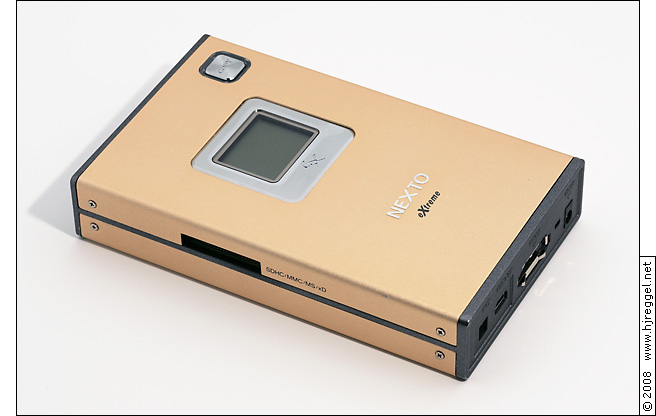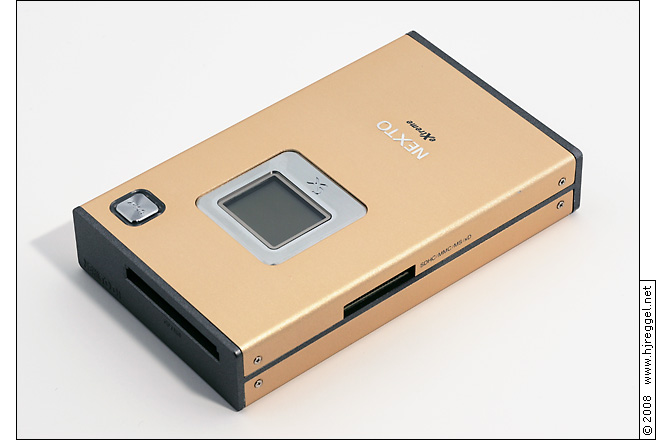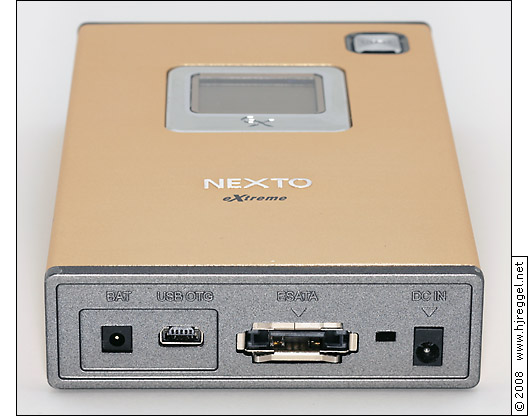
Quick Navigation: Features · Display · Card Slots · Connectors · Harddisk · eSATA
 |
| NEXTO eXtreme ND2700 |
There has been a lot of dirty talk about the display of the NEXTO series, so I'll add a section here.
The display is about 20×15mm² (1") in size. It's a monochrome LCD with soft blue backlight with a resolution of 96×64 pixel. That calculates to 120dpi horizontal and 110dpi vertical resoltion, which are totally normal values. There are mobile devices with displays of up to 200dpi, less than 150dpi should give no cause for complaints!
The display is used with two different character sets. The regular set displays 4 lines of 12 characters and is about the height of an Arial 9pt. The smaller set for browse mode displays 8 lines of 16 characters and is about the height of an Arial 6pt.
Final note: No, you can't view your images on the display!
 |
| NEXTO eXtreme ND2700 Card Slots |
The slot at the top edge is for CF-I, CF-II or Microdrive.
The combo slot at the side is suitable for full-size Memory Stick, SD/SDHC, MMC or xD-Picture Card. For all sub-types, including Memory Stick Duo, adapters are required.
 |
| NEXTO eXtreme Connectors |
Connector Panel, from left to right:
The most frequently asked question is about the choice of the harddisk. Basically, you can use any 2.5" SATA harddisk with 9.5mm height. Harddisks with larger height can be connected, but the bottom cover can't be attached. Regarding the storage capacity, there are no known compatibility issues up to 2TB, which is the size limit for MBR partitioning scheme and FAT32 filesystems. I have already successfully tested a 500GB harddisk.
As of today, 2008-04-24, there is no 7200RPM model that could outperform current 320GB 5400RPM models. I would strongly discourage from using 7200RPM models because of the higher power requirements and heat dissipation. During my tests, the Toshiba MK1652GSX showed excellent performance.
Please note that certain operations take longer, the larger the harddisk is. Formatting takes about 10 seconds per 100GB, a full integrity check of the FAT (Capacity Chk) takes about 20 seconds per 100GB. This means that using the largest harddisk available might not be the best choice, if you don't really need the space. However, the total capacity does not add a significant delay to the initial startup.
The eSATA standard is part of the SATA-II specification. Although eSATA devices can be connected to SATA hosts, and vice versa, don't expect that your eSATA device gets automatically detected as removable drive when connecting it to a SATA-I host. The eSATA standard introduced the different eSATA connectors for two reasons: To ensure full compatibility between host and device, and to prevent people from using improperly shielded internal SATA cables for external connections.
There are several passive Adapters from internal "L-shaped" SATA connectors to "Straight" eSATA connectors available. Make sure that you use properly shielded cables for all connections outside the shielded PC case. The simple rule is: If the cable is red, don't use it for external connections.
However, using passive adapters and properly shielded cables with SATA-I hosts does not make them eSATA compliant. In general, SATA-I hosts on older mainboards will usually detect the disk as internal disk, some will even require a scan for new hardware and might still not work properly. The SiI3114R in my PC automatically detects new devices as internal disk and works properly at the full speed of the harddisk. The ICH6R only detects the device after a rescan, and the disk only runs at 3.7-3.8MB/s.
If you want to add an eSATA port to your PC, you should prefer PCIe x1 cards over PCI cards. If you have the choice between different controllers, look out for Silicon Image, my add-on card with JMicron JMB360 does not run at the full speed of the harddisk. Using a PCIe x1 to ExpressCard adapter together with an ExpressCard eSATA adapter with SiI 3132 controller gives better results than the PCIe x1 eSATA card with JMB360 controller.
If you want to add an eSATA port to your Notebook, you should prefer ExpressCard adapters over CardBus adapters. While CardBus adapters will be able to read at about the full speed of the harddisk, the write performance will be limited to 12~20MB/s depending on the CardBus chipset. Please note that even the oldest SATA CardBus adapters with L-Shaped connectors will work properly with eSATA devices and detect them as removable drive.